This post contains affiliate links, which means I may earn a commission if you purchase through those links (at no extra cost to you).
I grew up making Orange Marmalade the old-fashioned way: soaking citrus overnight and boiling it rigorously to extract the natural pectin in the rind. When you follow my technique, you don’t need to add any store-bought pectin, and you get the best, cleanest-tasting marmalade.
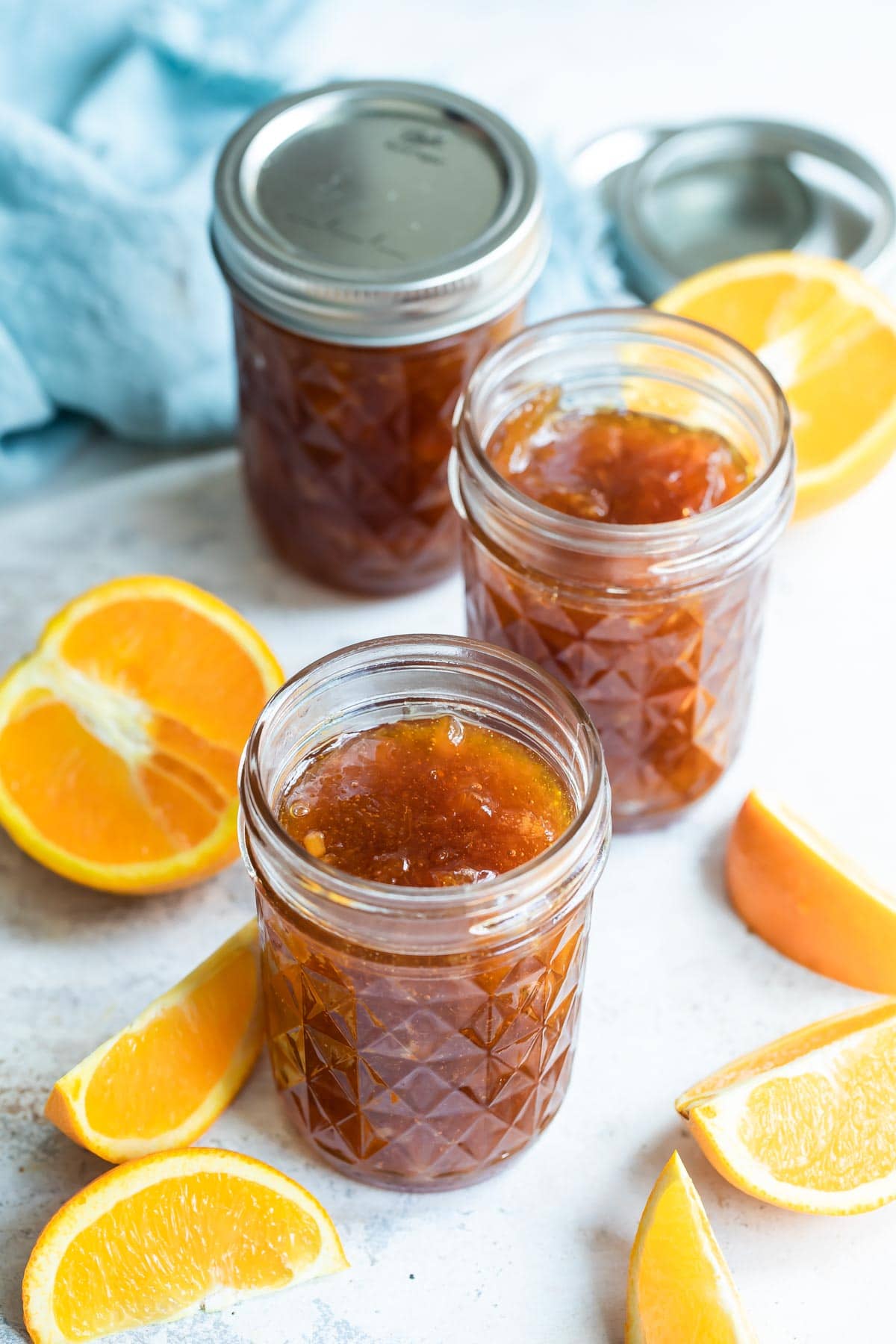
Nearly 1,000 5-star reviews prove this unfussy technique is simple and easy to follow. I also include my handy “cold plate test” so you can know for sure whether your marmalade is done or needs a little bit more time on the stove.
Home cooks everywhere are putting their abundant citrus to use to make their own homemade marmalade, and now you can, too. This recipe makes about 3 quarts total, or 12 (8 ounce jars). It freezes beautifully or you can process it in a water bath for canning.
Table of Contents
Marmalade Ingredients
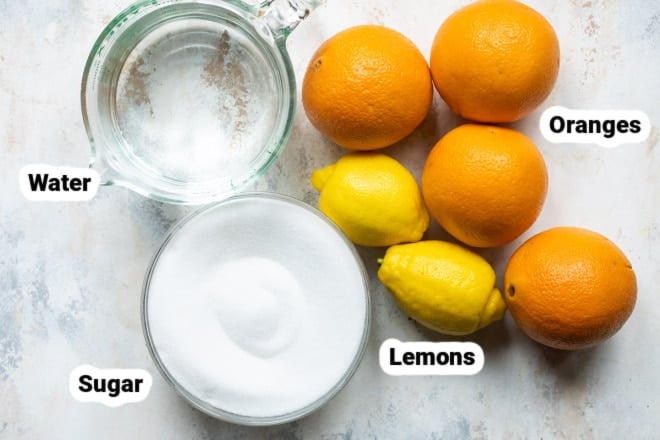
At a Glance: Here is a quick snapshot of what ingredients are in this recipe.
Please see the recipe card below for specific quantities.
- Oranges: This recipe is made with regular seedless oranges. You can definitely substitute Seville oranges if you can find them. They are only in season from the end of January to mid-February, but they have an intense flavor that is ideal for marmalade.
How to make Orange Marmalade
- Using a sharp knife, cut oranges and lemons in half crosswise, then into very thin half-moon slices. Discard any seeds. In a large pot (stainless steel), add the sliced oranges, lemons, and any fruit juice.
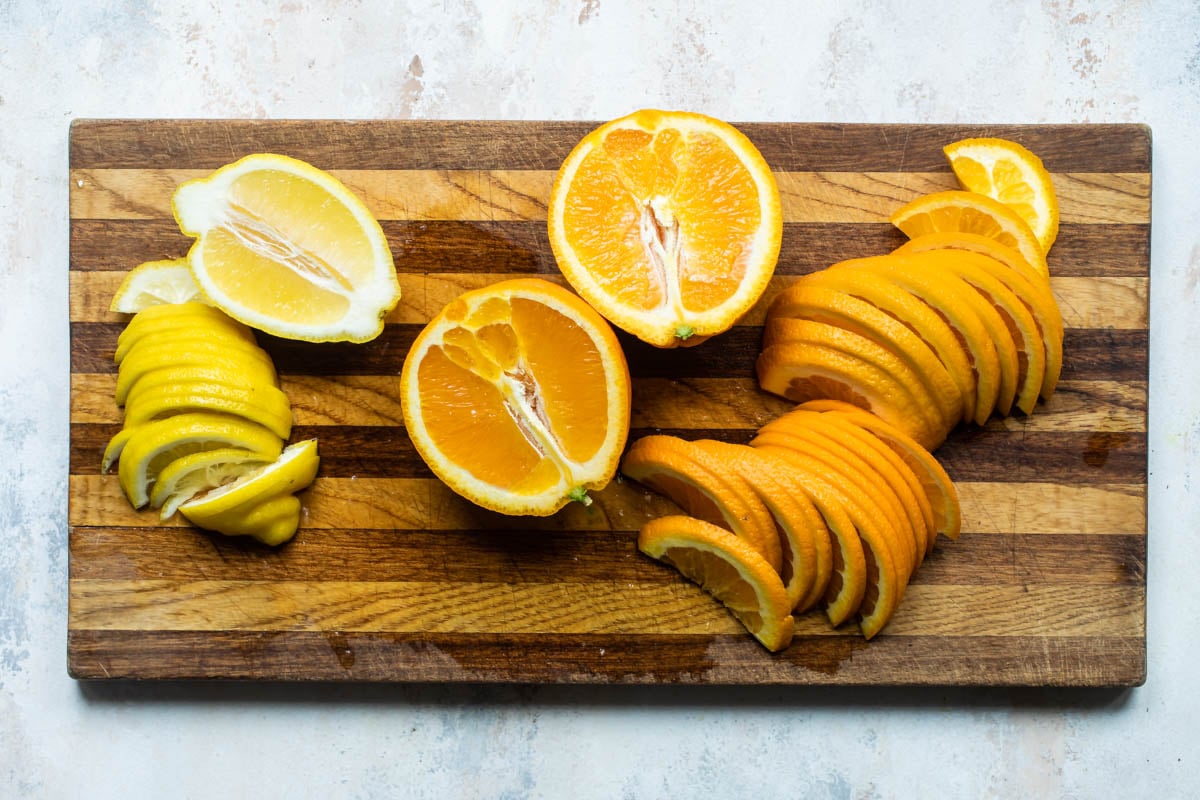
- Add water and bring the mixture to a boil over medium heat, stirring often. Remove from the heat and stir in the sugar until it dissolves. Cover and let stand overnight at room temperature.
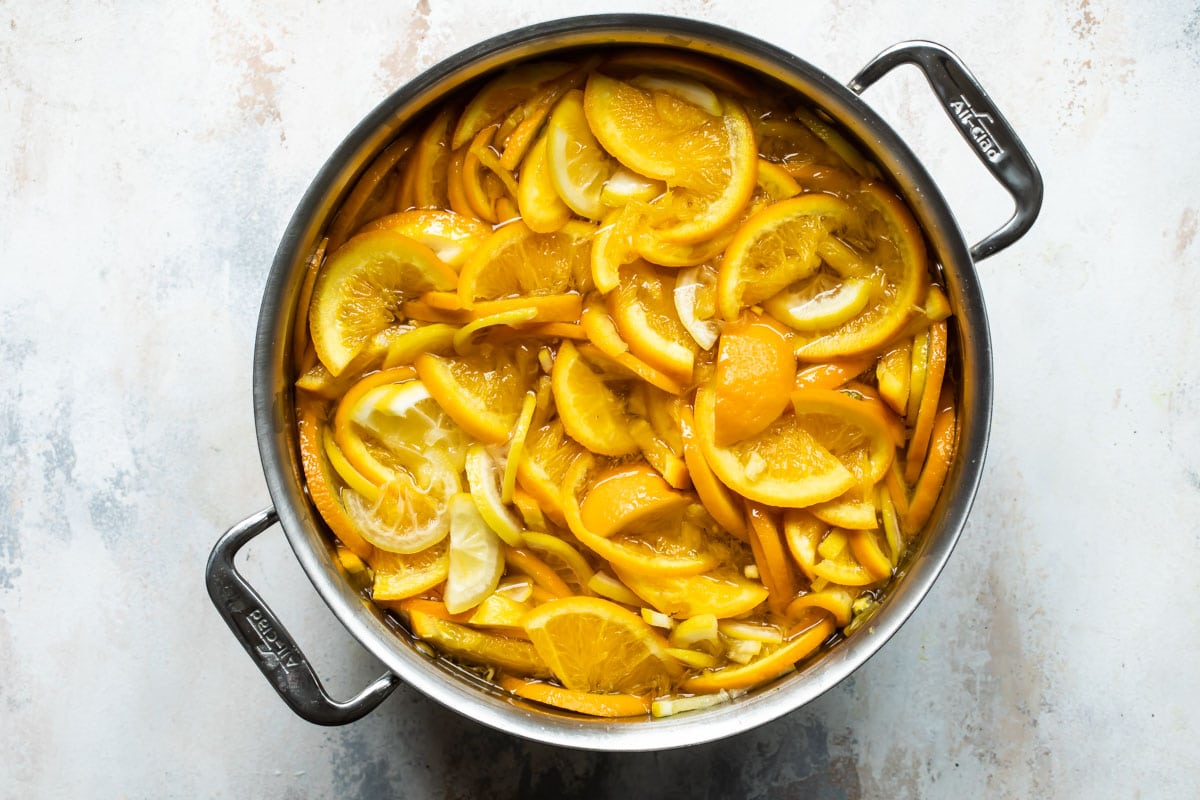
- The next day, bring the mixture back to a boil in the pot or saucepan. Reduce heat to low and simmer uncovered for 2 hours. Turn heat up to medium and boil gently, stirring often, for another 30 minutes. Skim off any foam that forms on the top. Cook until it reaches 220 degrees on a candy thermometer (you must hit this temperature for the natural pectin to gel with the sugar).
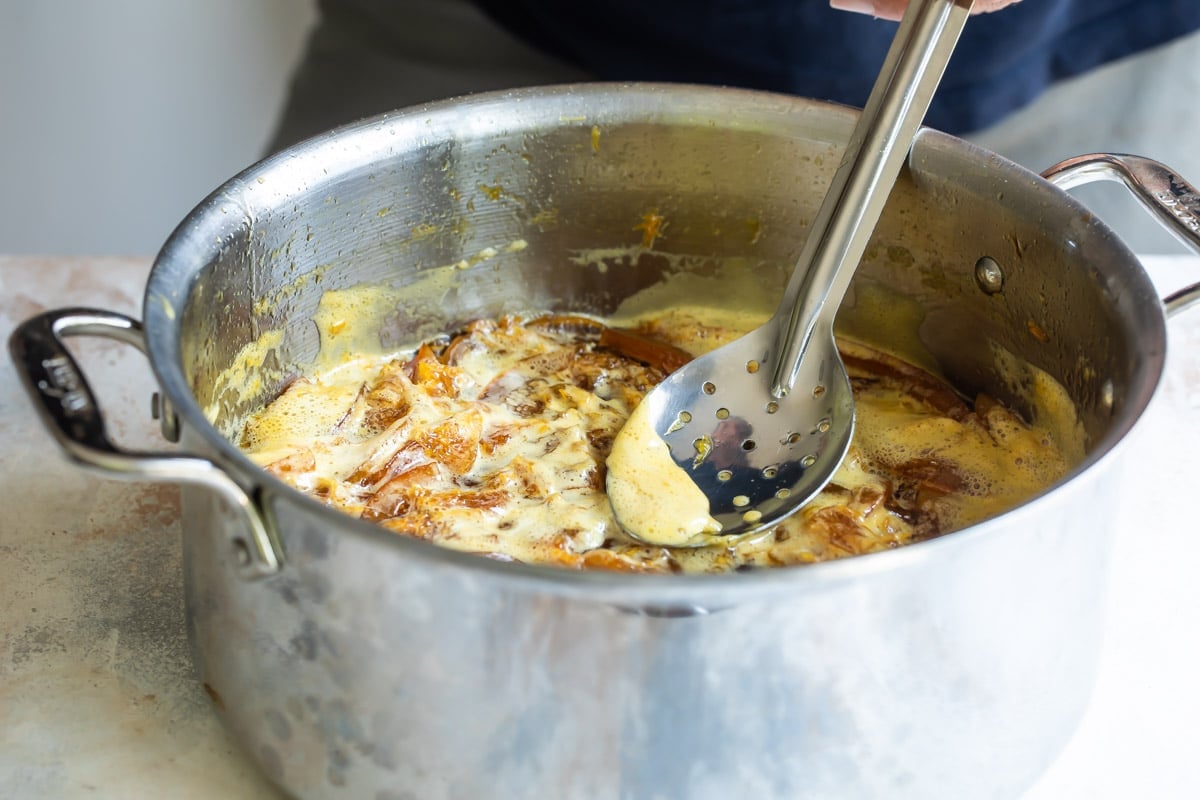
- To test if the marmalade is ready, place a small amount on a plate and refrigerate it until it’s cool but not cold. If it’s firm (neither runny nor hard), it’s ready. It will be a golden orange color. If it’s still runny, continue cooking it; if it’s hard, add a bit more water.
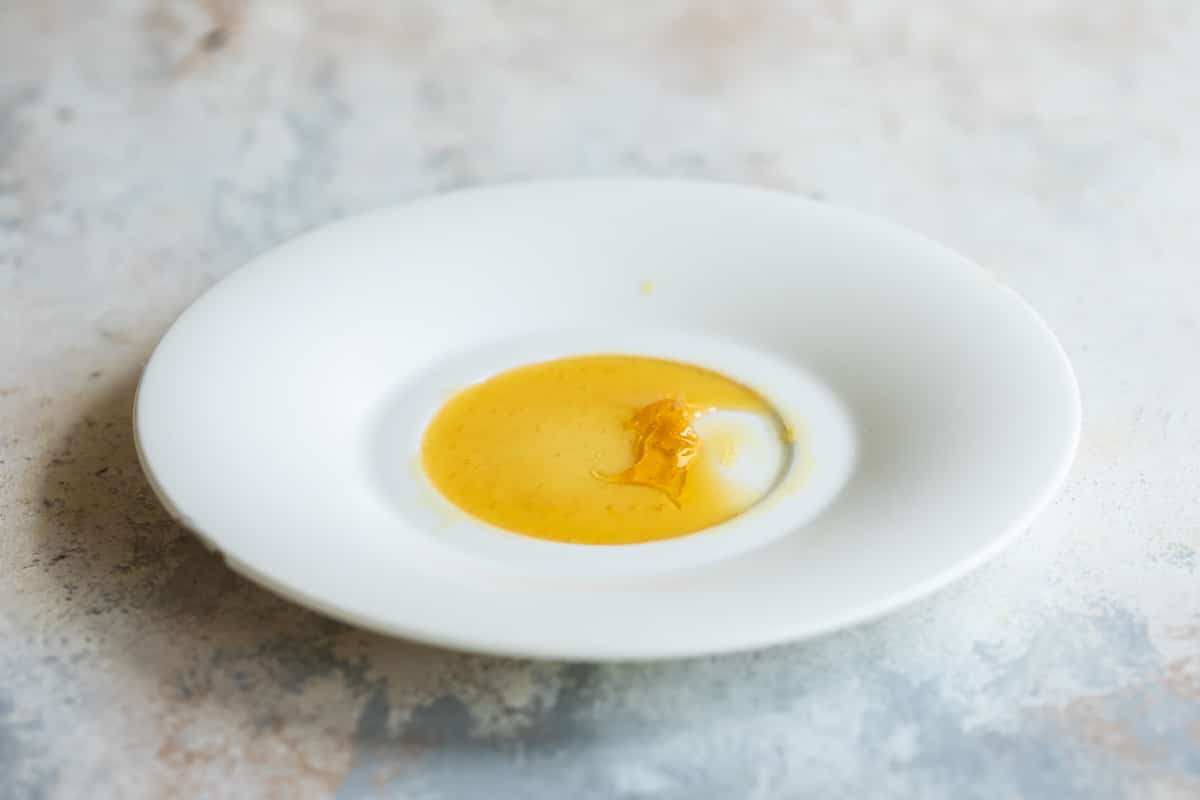
- Pour or ladle the marmalade into clean hot mason jars (I use this wide-mouth jar funnel for this recipe and so many others). Wipe the rims thoroughly with a clean damp paper towel, and seal with the lids. Chill in the refrigerator. It may take 24-48 hours for the natural pectin to set up properly.
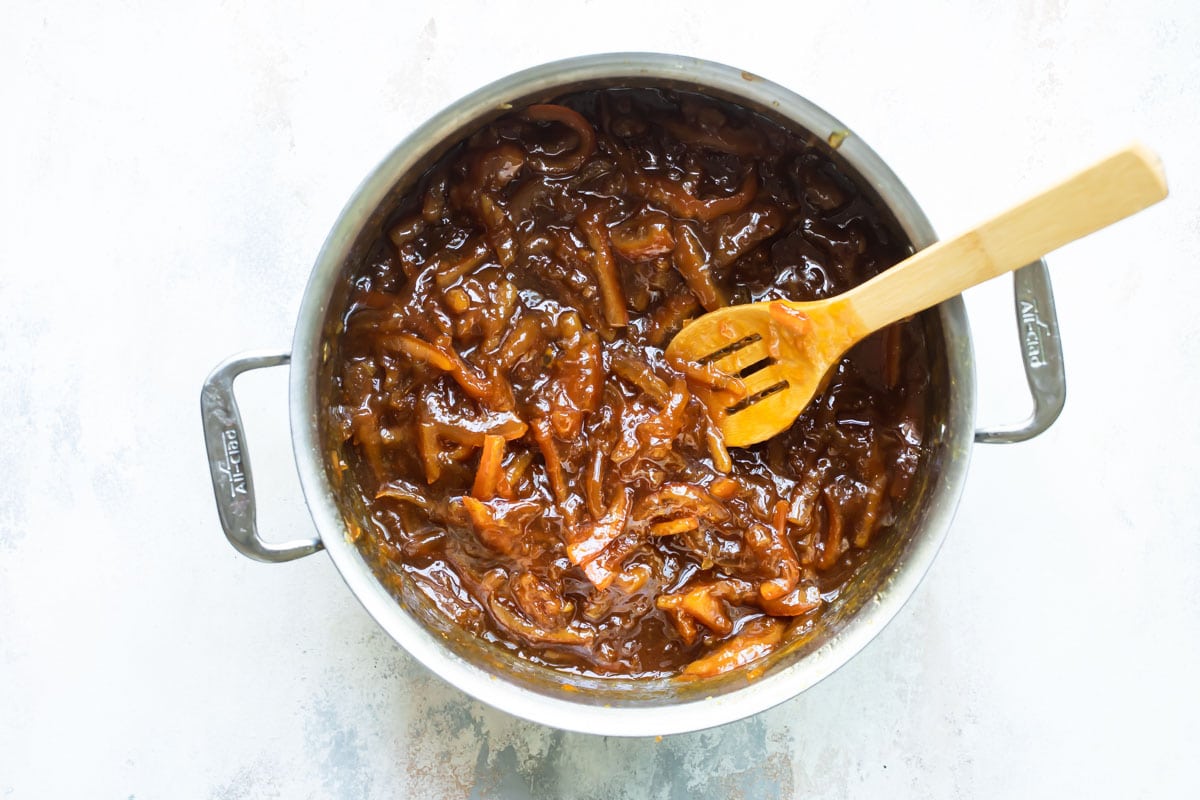
Orange Marmalade Recipe Variations
- Pectin: While many jam and jelly recipes require added pectin, you don’t need to add any here. Pectin is naturally concentrated in the pith of the orange (the bitter white part under the peel). This recipe coaxes out that natural pectin by letting the citrus soak overnight and then boiling it rapidly until enough water has evaporated that the mixture can reach 220 degrees.
- Agave nectar: Agave cannot penetrate and sweeten the peel as well as sugar can. When I tested it, the consistency was fine, but the rind tasted like raw rind. I don’t recommend this substitution.
- Low sugar: I haven’t tested low-sugar/alternative sweeteners in this recipe other than agave as listed above nor have I tweaked the amount of sugar in the recipe. I recommend seeking out recipes from experts in that area.
- Slow cooker: While it is technically possible to make marmalade in your slow cooker, it really depends on the power of your appliance. I no longer recommend that method because it isn’t reliable enough.
- Instant pot: Even with an overnight soak, the IP doesn’t break down the rind sufficiently. I don’t recommend this method.
Marmalade Recipe Tips
- Yield: This recipe makes about 3 quarts (96 ounces) of marmalade.
- If using 1/2-pint (8 ounce) jars, you’ll need 12.
- If using 1 pint (16 ounce) jars, you’ll need 6.
- If using the tiny jelly jars (4 ounce), you’ll need 24.
- Cold-plate test: To test if your marmalade is ready, spoon some hot marmalade on to a small plate and put it in the freezer to chill, or spoon some over an icy cold plate fresh from the freezer. If the mixture wrinkles slightly when you draw a spoon or finger across it, it has reached the setting point and is ready to go! If not, keep boiling and make sure the temperature reaches 220 degrees.
- Set-up time: Orange marmalade takes 24-48 hours for the natural pectin to set up completely. If it’s is still a little runny looking when it cools, check again in a day or two.
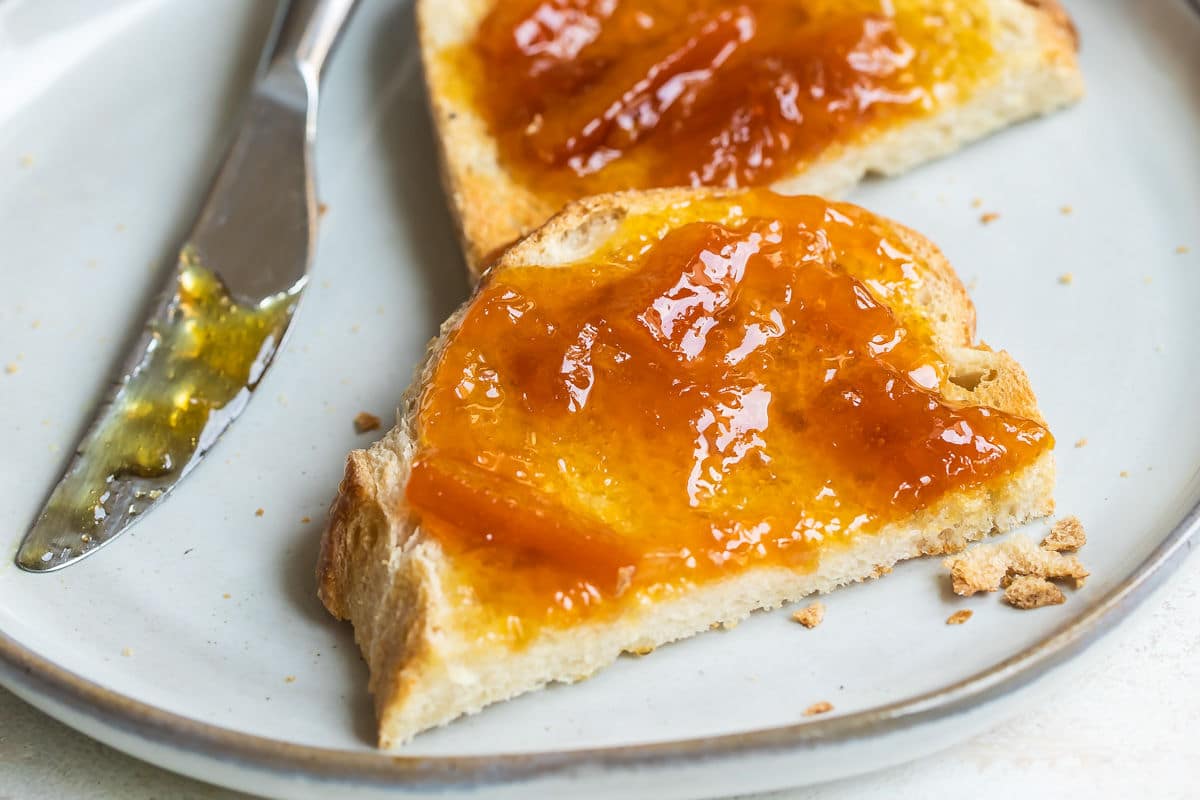
Storing and Canning Orange Marmalade
Storage: Store covered in the refrigerator for up to 1 month.
Freezer: Pack in freezer-safe containers or jars leaving 1/2-inch of headspace for expansion. Label, date, and freeze for up to 3 months. Thaw overnight in the refrigerator.
Canning: If putting up for storage, use a hot water or steam canner with a rack to properly seal lids on canning jars according to canning instructions. Otherwise, refrigerate and use within the month. Or, freeze for up to 3 months.
Frequently Asked Questions
Pectin is naturally concentrated in the pith of the orange (the bitter white part under the peel), so you don’t need to add any here. This recipe coaxes out that natural pectin by letting the citrus soak overnight and then boiling it rapidly until enough water has evaporated that the mixture can reach 220 degrees.
While it is technically possible to make marmalade in your slow cooker, it really depends on the power of your appliance. I no longer recommend that method because it isn’t reliable enough.
Even with an overnight soak, the IP doesn’t break down the rind sufficiently. I don’t recommend this method.
Agave cannot penetrate and sweeten the peel as well as sugar can. When I tested it, the consistency was fine, but the rind tasted like raw rind. I don’t recommend this substitution.
I don’t recommend making this recipe in a regular cast iron pan. It should be made in a non-reactive pan. Enameled cast iron, stainless steel, and non-stick are best and will not affect the color or taste of the marmalade
More fruit recipes
Pie and Tart Recipes
Fresh Fruit Tart
Fruit Dessert Recipes
Apple Crisp with Oatmeal
Cake Recipes
Lemon Bundt Cake Recipe
Muffins and Quick Breads
Banana Muffins
Join Us

Orange Marmalade
Equipment
- Jar funnel (for wide mouth jars)
Ingredients
- 4 large seedless oranges scrubbed clean (about 3 pounds or 8 cups slices, see note 1)
- 2 lemons (about ½ pound or 1 cup slices)
- 8 cups water
- 8 cups granulated sugar
Instructions
- Cut oranges and lemons in half crosswise, then into very thin half-moon slices. Discard any seeds. In a large stainless steel pot, add the sliced oranges, lemons, and any accumulated juices.
- Add water and bring the mixture to a boil, stirring often. Remove from the heat and stir in the sugar until it dissolves. Cover and let stand overnight at room temperature.
- The next day, bring the mixture back to a boil. Reduce heat to low and simmer uncovered for 2 hours. Turn heat up to medium and boil gently, stirring often, for another 30 minutes.
- Skim off any foam that forms on the top. Cook the marmalade until it reaches 220 degrees (you must hit this temperature for the natural pectin to gel with the sugar).
- To test if the marmalade is ready, place a small amount on a plate and refrigerate it until it's cool but not cold (see note 4). If it's firm (neither runny nor hard), it's ready. It will be a golden orange color. If the marmalade is runny, continue cooking it; if it's hard, add a bit more water.
- Pour the marmalade into clean hot mason jars; wipe the rims thoroughly with a clean damp paper towel, and seal with the lids. Chill in the refrigerator. It may take 24-48 hours for the natural pectin to set up properly.
Recipe Video
Notes
- Oranges: This recipe is made with regular seedless oranges. You can definitely substitute Seville oranges if you can find them. They are only in season from the end of January to mid-February, but they have an intense flavor that is ideal for marmalade.
- Yield: This recipe makes about 3 quarts (96 ounces) of marmalade.
- If using 1/2-pint (8 ounce) jars, you’ll need 12.
- If using 1 pint (16 ounce) jars, you’ll need 6.
- If using the tiny jelly jars (4 ounce), you’ll need 24.
- Storage: Store covered in the refrigerator for up to 1 month.
- Cold-plate test: To test if your marmalade is ready, spoon some hot marmalade on to a plate and put it in the freezer to chill, or spoon some over an icy cold plate fresh from the freezer. If the mixture wrinkles slightly when you draw a spoon or finger across it, it has reached the setting point and is ready to go! If not, keep boiling and make sure the temperature reaches 220 degrees.


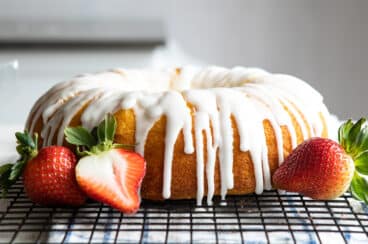

I was wondering if it would be okay if I had 3 oranges one lemon and one lime.
Hi Myndi, yes! Limes also work in marmalade. – Meggan
Hello, I am making this mark now and it turned brown, is it burnt? Should I throw it away?
Hi Kimberly, I would taste it! It does darken as it’s cooked, so it may be a part of the cooking process. Also, did you use dark brown sugar? That may also be why. If it tastes burnt, then I would throw it away, but otherwise, it might just be cooking down. Let me know how it turns out. – Meggan
Meggan, I love marmelade and just happened to come across your recipe. My question is, can I use a sugar substitute like Stevia? I am diabetic and 8 cups sounds like a lot of sugar!
Hi Catharina! I haven’t tried it with Splenda. I am not honestly not sure if that would work because I tried it with agave (which also has a lot of sugar) and the agave could not properly penetrate the rind to make it taste good. I suspect Splenda can’t either. I’m not sure. I do agree 8 cups is a lot. You could try it, but based on my agave test, I guess I am not super optimistic. I don’t want you to be disappointed. But if you took out the rind after cooking it might be fine. I don’t know if you could strain it and the rind would stay behind? Something to try if you want to, I guess! -Meggan
So good! Just made this and it’s the PERFECT bend of sweet & bitter. Love, love, love how easy it was to make!
I am making my second batch of this marmalade in 2 months, as I write. I have never made marmalade before and my family can’t get enough of it. I make a lot of jams but this recipe is both simple and easy to follow. The simplicity of letting it sit over night is great and you are correct it really sets well in the jars. I even sent my in-laws back in the UK a jar because it was such a hit here at home. Thank you and I love reading all the posts and learning from them!
Meggan
Happy weekend!
Do I cover the pot when cooking?
Thank you
Jenny
Hi Jenny! No, you don’t cover the pot when it’s cooking. I will update the recipe so this is clear. I do cover the pot when I’m letting it sit overnight, but other than that, you want the water to cook off so you can get it to 220 degrees and the pectin is activated. Thanks! -Meggan
My second batch of orange marmalade..
Great recipe and tripled the amount this time…
My husband says its the best marmalade he’s ever had..
Thank you!! ❤️
You’re so welcome Caroline! I am glad it’s a hit! -Meggan
“Got an orange tree in the backyard and a passion for orange marmalade? Click and slide the number next to “servings” on the recipe card below to adjust the ingredients to match how many you’re feeding—the recipe does the math for you, it’s that easy.”
I’m not seeing a way to slide the numbers on the recipe card. Am I missing something here? It’s just myself and I don’t want jars and jars of marmalade… could you tell me the measurements for 12 oz please?
Thank you and can’t wait to try this!!! 🙂
Hi Susan! Sorry for the confusion. The recipe slider (just for future reference) is right by “Servings” and you’ll see the number of servings is linked. So you’ll see “96 servings” and the 96 is blue and underlined. So you can click on that blue 96 and adjust the servings. In any case! I would say the smallest reasonable batch is 24 ounces, or 1 orange. So in that case you want 1 orange (about 12 ounces), 1/2 lemon, 2 cups sugar, and 2 cups water. I have never tested a small batch like this, but I am sure it would work fine. I’ve done a half batch (2 oranges/1 lemon/4 cups sugar/4 cups water) and had no issues. Thanks for the question and if you need anything else, just let me know! -Meggan
Should there be any additional time if making at high altitude?
Hi Lynn, good quesiton! Maybe. Probably. I found something on the internet about this which you can take a look at if you want to. It depends on your altitude, but it sounds like yours might be done sooner than mine. The other thing is, this article is talking about pectin which is added to normal jam recipes. But in the case of orange marmalade, we’re talking about pectin within the pith that breaks down. So I have no idea if it performs the same way. I do have a “test” you can do where you put some on a plate and refrigerate it and see if it gels. So you could do that a bunch of times. Ultimately it’s up to you, whether you want to take a gamble on it or not. Overall I find this recipe to be very forgiving. And I know people in Mexico have made it at around 6,000 feet above sea level. Good luck! -Meggan
https://www.exploratorium.edu/cooking/icooks/01-06-03.html
I live in Colorado at 9,000 ft. The only thing I’ve noticed is that I don’t need the extra 30 minutes of hard boil at the end. Mine was set at the end of the 2 hour simmer. I burned it the first go around using the extra 30 minutes. It was heartbreaking!
Hi,
I’ve never made marmalade, and I think I already made a mistake!! I put the water and sugar in the pit at the same time, and brought to boil. It’s now sitting until tomorrow as recipe says. Should I start over? Will it still work? Thanks, Sandra
Hi Sandra! Don’t start over! This is a very forgiving recipe and I’ve honestly made that exact same mistake myself. The marmalade will be just fine. Just let it sit overnight and cook it tomorrow for a couple of hours, and then bring it to 220. You’ll be fine, I’m so sure. Don’t worry! It’s going to be fine! Thanks. -Meggan
Hello,
I’m intrested on making your Orange Marmalade and the recipe seems simple enough, however,I do have one question.
After the first cook should i place it in the fridge or leave it out on the counter? We are careful not to let things stay out too long and I am aware this is citrus but better be safe than sorry. 🙂
Hi Nicole! Food safety is REALLY important to me, I have my ServSafe Food manager’s license. I totally get it! This is fine to leave out on the counter. That’s how it works. It’s one of those old-fashioned techniques that sounds weird but it’s fine. Thanks for checking! -Meggan